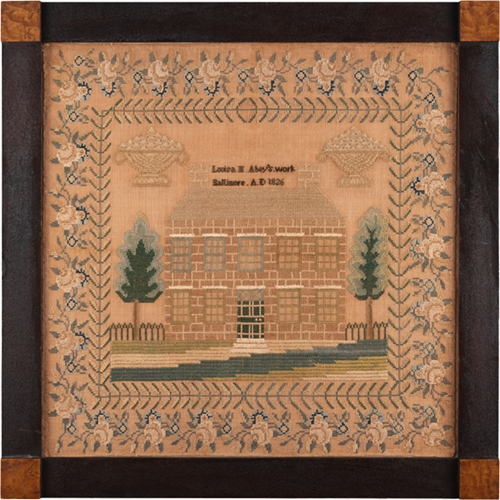Louisa M. Abey
Baltimore, Maryland, 1826

Samplers featuring architectural depictions are some of the most desirable early 19th century American samplers, and many of the finest of these were made in Baltimore, which was, in 1840, the second largest city in the United States.
Gloria Seaman Allen’s outstanding book, A Maryland Sampling: Girlhood Embroidery 1738 – 1860 (Maryland Historical Society, 2007), presents an excellent study of the samplers made in Maryland, with pages 201 through 224 devoted to Baltimore samplers featuring domestic architecture. Many of these excellent pieces present fully-developed houses and wide floral borders. These samplers were made between 1798 and 1840 in four specific neighborhoods of Baltimore: Fells Point, Old Town, Federal Hill and Central Town.
Louisa M. Abey’s sampler is both visually striking and carefully crafted; she signed it quite directly, “Louisa M. Abey’s work Baltimore A. D. 1826.” The large, detailed house sitting on an unusual, graphic lawn fairly fills the interior of the sampler. Two baskets of fruit and two lush and leafy trees provide further pictorial interest. Both the inner border of slender leaves on a straight edge and the outer border of stylish blossoms and buds frame the composition well. This is a sampler with remarkable visual appeal.
Louisa was born circa 1814 to Jacob Abey and Sarah (Shepherd) Abey, who lived in Federal Hill and were married at the Zion Lutheran Church of Baltimore in 1806. Jacob served in the 51st regiment of the Baltimore militia during the War of 1812; he later stated his occupation as that of fisherman but the family had substantial means and social standing. Sarah Shepherd descended from a notable family from lower Maryland; according to the History of Baltimore City and County by J. Thomas Scharf, the Shepherd ancestors figured conspicuously in Revolutionary annals.
Louisa remained single and by 1860 was living with the family of her late sister, Elizabeth (Abey) Mowell. In 1826 Elizabeth had married Peter Mowell, the owner of very successful iron furnaces who also had involvement with railroads, banking and insurance concerns. They had ten children and after Elizabeth’s death in 1854, Louisa lived with this family for many years, on, or next to, the family’s estate, Glencoe, which is now listed on the National Register of Historic Places. Louisa died in a carriage accident at age 59 in 1873 and her obituary was reported by the Baltimore Sun.
The sampler was worked in silk on linen and is in excellent, original condition. It has been conservation mounted and is in an excellent period mahogany and maple cornerblock frame, with UV filter glass.
